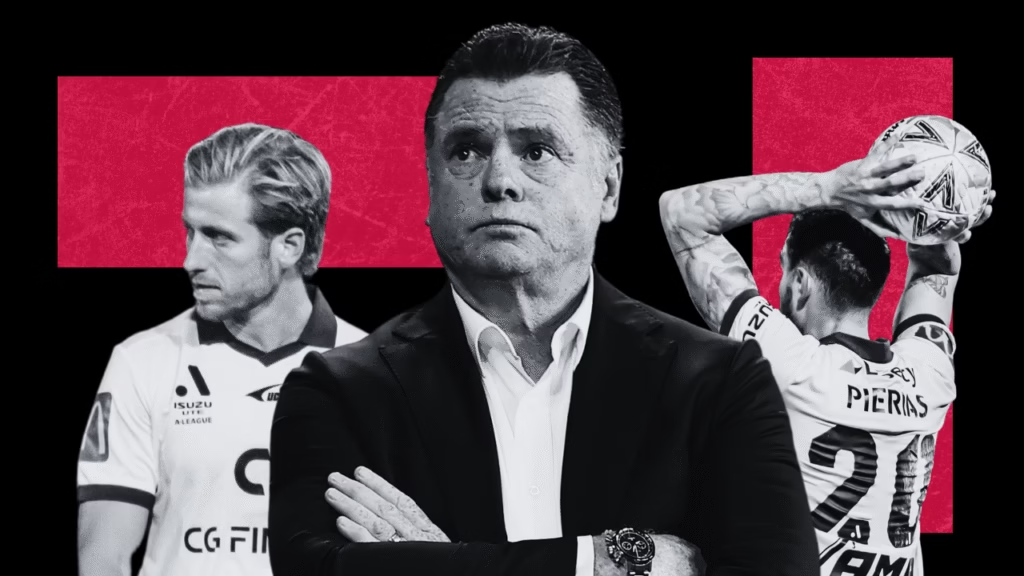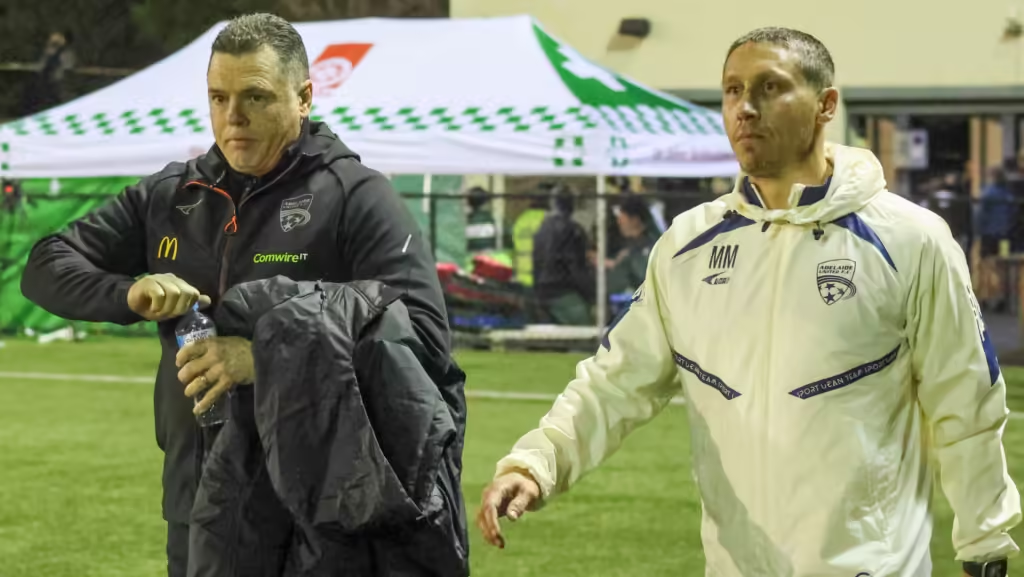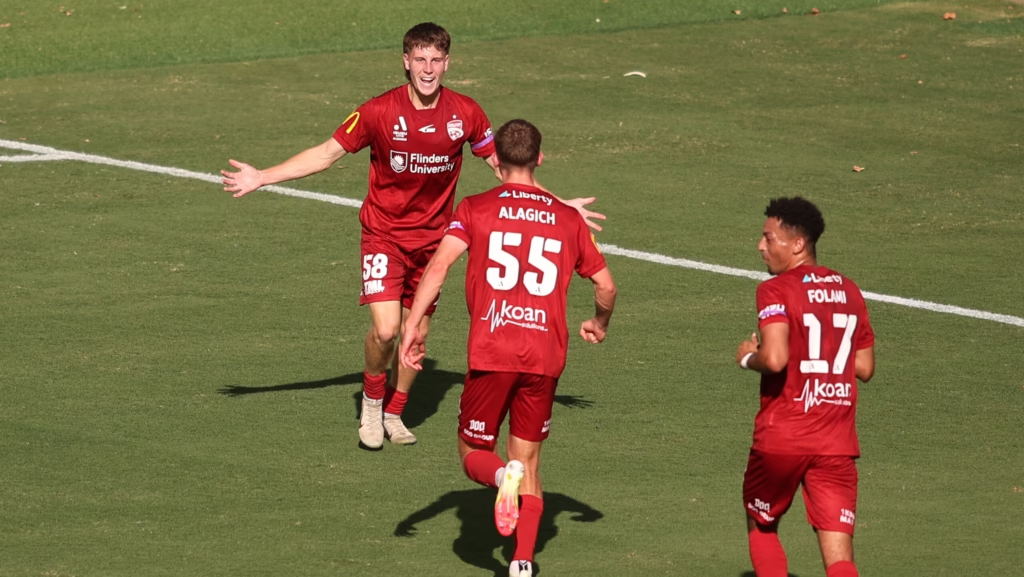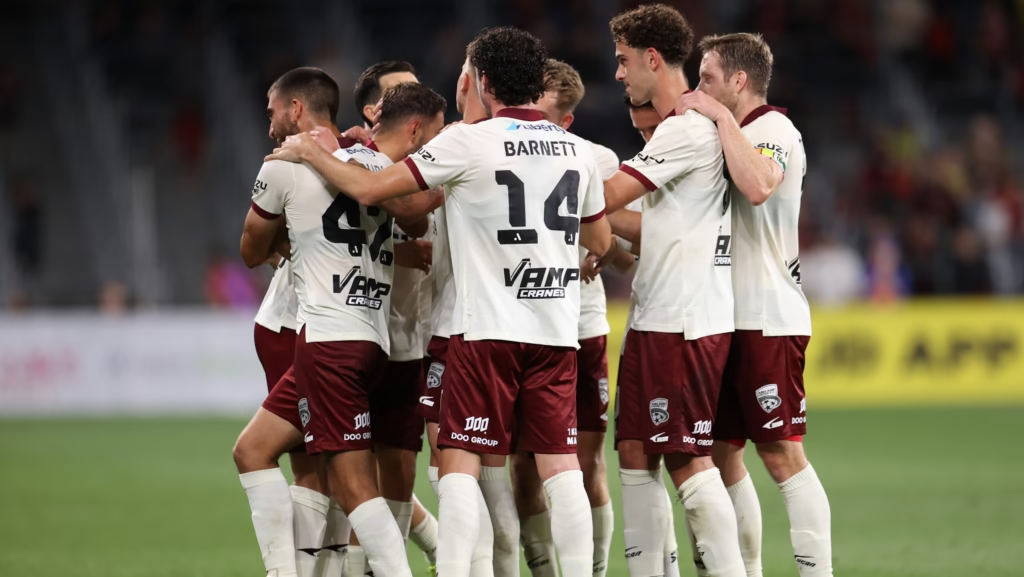
Adelaide United 2024/25 A-League Men's season review. Photos: Marcus Robertson and Joshua Davis / Round Ball Australia.
Adelaide United came into the 2024/25 A-League Men season as a complete unknown and ended up presenting the ultimate ‘season of two halves’, in Round Ball Australia’s next season review.
In the off season, key attacking pieces such as Hiroshi Ibusuki and Nestory Irankunda departed the club, along with most of the defensive unit.
In their place came legendary Dutch centre back Bart Vriends, unproven, injury-prone striker Archie Goodwin, A-League veteran Ben Folami, and pacey winger Dylan Pierias.
Having missed finals the season before, Adelaide were the most difficult team to place heading into this campaign.
The pieces seemed to be there – and they had a good cup run – but it seemed the team would either be lights out amazing or absolutely awful, and until game day you’d have no idea which team would show up.
The board even told fans at a members forum that they were in some sort of rebuilding mode, while only weeks late coming out in the media to announce that a top four finish was the aim.
Fans, media… nobody knew what to expect. Not even the club themselves could commit.
Season Grade: C-
When even the club’s board itself is unsure quite which level to set their sights, it’s difficult to evaluate a season against any universal expectations.
However, this was a side that, for at least half of the season, was a genuine title contender and Auckland’s only real threat.
Carl Veart, the players, the fans – everyone saw this as the year this side would finally be a serious shot at winning silverware.
Yes, conceding goals was still a problem, and home form was, to put it lightly, unacceptable. But it never felt like the Reds were ever really out of a game in those early months.
But it wasn’t to be. January rolled around, and so did absolutely no movement in the transfer market despite glaring depth issues, highlighted by the departure of four players for international duty that month.
Mark Milligan also departed, the team’s form stagnated (a run of eight games without a win), and even with Goodwin taking home the league golden boot, the side dropped from top spot to barely limping into finals off the back of Sydney’s somehow even worse finish to the season.
A sixth place finish would seem about right for a team that nobody could place. But after that promising start, it’s difficult to view the season as anything but a missed opportunity.
It wasn’t a complete failure – they made the finals, after all. But it was certainly disappointing.

The Collapse
Lack of depth, instability, poor defending; all storylines Adelaide fans will come to recognise from recent seasons.
But in this campaign they all fed into what is arguably one of the greatest (or worst, depending on your view) stories in A-Leagues history.
It was a fall from grace that turned Adelaide from title contenders to literal wooden spoon-worthy form.
As aforementioned, the usual storylines fed into the bigger picture.
A shoddy defence with no depth was again neglected in January, none of the three goalkeepers used really impressed, the side couldn’t win at home and the lack of depth was exposed.
But it was constantly papered over: yes the defence has been shaky but we’re scoring lots; no we don’t have much depth but we’ve lost a lot of players to international duty.
No straight answers, no clear direction. It came to the point where the excuses ran out, and with only a few rounds left in the season Veart finally admitted they had to do more work defensively to stand a chance.
The excuses ran out, and coincidentally the club announced they would not be exercising their option to extend his contract, leaving him knowingly without a job for next season, with a handful of games still to play.
It was clear in the back end of the season, especially after that announcement, that the players and coaches seemed almost resigned to missing finals again.
Sloppy play seeped in, Max Vartuli was given the gloves and other players looked checked out. Only for Sydney to somehow bottle harder and gift the Reds that sweet sixth spot.
In years to come teams will look at this Adelaide season as the perfect example of what not to do when fighting for silverware.
No mid-season investment in a promising on-field product, a highly volatile style of play with laissez-faire approaches to defending and accountability, papering over issues while the going is good, and refusing to change when things start to falter.
All culminating in the loss of the club’s longest serving coach, and a tremendously underwhelming performance in what can only be described as a consolation elimination final.
It was a fall like no other.

The kids are all right
While the overall story of the season is one of a fall from grace, many individuals within the club really shone.
Archie Goodwin came into the side with big boots to fill, with Ibusuki departing after a career-best season. But he stepped up when it was needed.
He was the joint golden boot winner of the league, a reliable source of goals, and a spark of energy in the front line.
It was really a season of vindication, proving what he’s capable of when fit and given the chance, and will doubtlessly have eyes on him for an overseas move if his form carries over into next season.
He also walked away with the club Rising Star, Members’ and Red Army Player of the Year awards.
Zach Clough and Stefan Mauk were also key contributors, their experience and quality helping many of the younger players in the side bed in and perform.
Both had career-best seasons in terms of goal contributions: Mauk with 11 g/a, and Clough with 16 g/a.
But it was really two youngsters who showed their chops, delivering on promise they showed last campaign.
20-year-old defender Panagiotis Kikianis had two goals and an assist to his name, looked calm and collected in possession, and was by far the stand out player in what was an admittedly awful defensive unit.
He showed passion, fight, and offered a great profile on the ball – able to play lovely line breaking passes that regularly relieved pressure on the Reds’ backline.
It didn’t go unnoticed, either, with his team-mates voting him the club’s Players’ Player of the Year.
And slightly further up the pitch, Ethan Alagich quickly became the talk of the town.
He was just what Adelaide had been looking for: a proper box-to-box midfielder, with the versatility to play a number of other roles in the centre of the park.
He formed a great partnership with Jay Barnett as the pair became one of the best double pivots in the league, and he also demonstrated his value on the ball, scoring twice and providing two assists.
He was the side’s engine in the midfield, helping to control the tempo and dictate the way the side played in and out of possession.
For a player so young, he looked as if he’d been doing it at this level for decades.
It was only fair, then, that he was awarded the Aurelio Vidmar Medal, recognising him as the club’s player of the season.
However for all the good, there were a few notably poor performers.
Bart Vriends joined the club with high expectations, and outside of a few games and moments, he looked a step or two behind the pace of play, often being bailed out by the considerably less experienced Kikianis.
None of James Delianov, Ethan Cox or Max Vartuli really looked assured or capable between the sticks, and it seemed even the coaching staff were not exactly certain on who deserved the starting spot, chopping and changing throughout the season.
In fact, there were a number of occasions where poor goalkeeping really let the side down, and arguably cost the team a handful of points that would’ve made what was a hail Mary shot at finals a bit more comfortable.
And, unfortunately, Ryan Kitto was again behind the eight ball. The Reds captain had a more restrained role in possession this season, helping form a back three in possession while Pierias on the opposite side bombed forwards.
But even then, he was clumsy in defence, and even moved back into a winger role by the end of the season, with Javi Lopez seen as a better option at left back.

A base to build on
It was a disappointing end to the season after such highs to kick things off, and a poor performance in a finals game with nothing to lose was the cherry on top.
Fans certainly became disillusioned with the ownership and football operations side of the club: the downturn in form, bizarre treatment of Veart’s job status, and lack of transparency all key concerns.
But by the miracles of a Sky Blue capitulation, the side made finals. And throughout the season showed that there’s a core squad that can easily compete for the tile given a bit of help, depth, and stability.
It’s a big off-season. Fans will be expecting signings to improve in key areas – especially in defence and between the posts.
And the club would be foolish to pass on the opportunity to build around some of the incredible young players they’ve developed.
United has already announced the appointment of Airton Andrioli as head coach, and club legend Craig Goodwin will make another return to the Reds.
Some more good recruitment and a less vulnerable game-plan, and this side could be a threat next season.
But that would seem to be a lot to ask from a club that failed to capitalise when things were going well this term.
